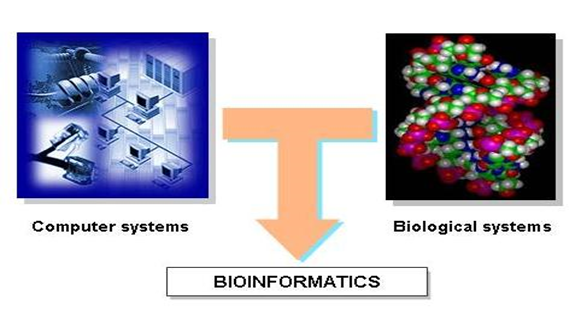Authors: Prashant Raghunath Shingote, Shriram J. Mirajkar, and Prashant B. Kale
There are a number of definitions given to Bioinformatics depends on the field of the person involved. A biochemist talks about “doing bioinformatics” when he uses computers to store retrieve, analyze or predict the composition of the structure of a protein molecule A computer specialist uses the term "informatics" for computer hardware, software, and information theory. Bioinformatics is thus use of computers for the acquisition, management, and analysis of biological information. Alternatively it could also be defined as research, development, or application of computational tools and approaches for expanding the use of biological, medical, behavioral or health data, including those to acquire, store, organize, archive, analyze, or visualize such data.
The term bioinformatics was coined by Paulien Hogeweg and Ben Hesper in 1978 for the study of informatics processes in biotic system.

Bioinformatics deals with any type of biological data that is of interest to molecular biologists: DNA and protein sequences, gene expression (microarray), retrieval of articles from the literature databases or analysis of raw data collected from laboratory or breeding experiment, using suitable software tools.
Fields Related to Bioinformatics
Bioinformatics has various applications in medicine, biotechnology, agriculture, etc. The following research fields are integral components of Bioinformatics
Computational Biology - the development and application of data-analytical and theoretical methods, computer algorithms, mathematical modeling and computational simulation techniques to analyze the biological data.
Genomics - is any attempt to analyze or compare the entire genetic complement of a species by comparing representative subsets of genes within genomes.
Proteomics - the study of proteins - their location, structure and function which involves the identification, characterization and quantification of all proteins involved in a particular pathway, organelle, cell, tissue, organ or organism that can be studied in concert to provide accurate and comprehensive data about that system.
Structural genomics -refers to the analysis of macromolecular structure particularly proteins, using computational tools and theoretical frameworks. One of the goals of structural genomics is the extension of idea of genomics, to obtain accurate three-dimensional structural models for all known protein families, protein domains or protein folds.
Comparative genomics - is the study of the relationship of genome structure and function across different biological species or strains. The comparative study of the genomes of the various grasses (e.g. http://gramene.org)
Functional genomics - is a field of molecular biology that attempts to make use of the vast wealth of data produced by genome sequencing projects to describe genome function. Functional genomics uses high-throughput techniques like DNA microarrays, proteomics, metabolomics and mutation analysis to describe the function and interactions of genes. In 1998 the National Plant Genome Initiative (NPGI) was established. The goal of the NPGI is to develop a basic knowledge of a structures and functions of plant genomes and translate this knowledge to comprehensive understanding of all aspects of economically important plants and plant processes of potential economic value.
Agroinformatics / Agricultural informatics - concentrates on the aspects of bioinformatics dealing with plant genomes.
Systems biology - is the coordinated study of biological systems by investigating the components of cellular networks and their interactions, by applying experimental high-throughput and whole-genome techniques, and integrating computational methods with experimental efforts.
Applications of Bioinformatics
Crop improvement - Comparative genetics of the plant genomes has shown that the organization of their genes has remained more conserved over evolutionary time than was previously believed. These findings suggest that information obtained from the model crop systems can be used to suggest improvements to other food crops. At present the complete genomes of Arabidopsis thaliana (water cress) and Oryza sativa (rice) are available.
Microbial genome applications - Microorganisms have a variety of uses in baking, brewing and food industries. In the environment, some have been found to involve in the assimilation and conversion of nutrients in the soil. The arrival of the complete genome sequences has opened up enormous opportunities for energy production, environmental cleanup, industrial processing and toxic waste reduction. By studying the genetic materials of these microorganisms, there unique abilities to survive under extreme conditions can now be understood.
Biotechnology - Some microorganisms have been identified to have potential practical applications in industry and environmental remediation. They thrive in water temperatures above the boiling point and therefore may provide heat-stable enzymes suitable for use in industrial processes. Other useful microbes are used by the chemical industry for the biotechnological production of some amino acids, polysaccharides, and other chemicals. Other bacteria are critical for manufacturing dairy products like buttermilk, yogurt and cheese; others are used for production of beer, wine, breads and sausages and other fermented foods. Understanding and exploring the physiology and genetic make-up of several bacterial strains is invaluable for food and pharmaceutical industry.
Molecular medicine - The completion of the human genome sequencing brings opportunities to understand the genes directly associated with different diseases more clearly and the molecular basis involved in developing diseases. This new knowledge of the molecular mechanisms of disease will enable better treatments, cures and even preventative tests to be developed.
Insect resistance - Genes from Bacillus thuringiensis that can control a number of serious pests have been successfully transferred to cotton, maize and potatoes. This new ability of the plants to resist insect attack means that the amount of insecticides being used can be reduced and hence the safety of crops is increased.
About Author / Additional Info:
I have completed my graduation and post graduation in Agricultural biotechnology. From last 4-5 years I have been working on different aspects of plant molecular genetics and functional genomics. I have published nearby 10 publication maximum of which are in peer reviewed journals having impact factors.